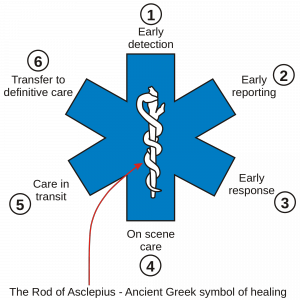Q. What is the area CCEMS covers?
A. Within the boundary of Crawford County. We cover 572 square miles. We have three stations (Girard, Pittsburg, and Frontenac) staffed 24/7.
Q. How many ambulances cover the county?
A. We will have a fleet of eight ambulances as of September 1, 2016. We also have two special response trailers, three administrative trucks and a Rescue vehicle for specialized extrication responses.
Q. What does EMS stand for?
A. Emergency Medical Service.
Q. What is the difference between EMT-B, EMT-I, and Paramedic?
A. EMTs provide basic life support. They can all administer oxygen, and in some/most regions, they can administer Epi pens, aspirin, oral glucose, glucagon, and assist patients with their Nitro. They can provide CPR including AED and ventilatory adjuncts (OPAs and NPAs, and in some cases the Combitube or EOA), spinal immobilization, and splinting. They are also fully capable of taking vital signs including blood pressure, pulse, spO2, lung sounds, respiratory rate, BGL, etc. Paramedics on the other hand, have significantly more schooling. They are in care of cardiac monitors and can interpret 12-lead EKGs. They can administer an extensive list of medications including Narcan, respiratory medications such as albuterol and Atrovent, antidysrhythmics such as Lidocaine, Amiodarone, Adenosine, Cardizem, medications for allergic reactions such as epinephrine and benadryl, as well as many other medications depending on their local protocols. They can perform RSI (Rapid Sequence Induction/Intubation) as well as normal intubations. They also have other airways depending on location such as LMAs or the King airway and can perform needle decompression and cricothyrotomy. They can perform interventions such as syncronized cardioversion, defibrillation, and transcutaneous pacing. And of course they can start IVs (through which the majority of medications are given), and can also do IOs (where a needle is drilled most standardly into the tibial tuberosity) but can also give medications intranasally, IM, PO, ETT, and SQ.
Q. How can I become CPR Certified?
A. American Red Cross CPR classes take just a few short hours. Whether you’re a medical professional who needs re-certification, or you simply want to learn how to respond in the event of an emergency, their in-person, online, and best-in-class blended Simulation Learning courses make it east to get CPR certified. CPR certification takes just a few short hours, but can help you add years to someone’s life. Successful completion of an in-person or blended learning course gives you a two-year certification in adult and/or pediatric CPR. Three ways you can get CPR Certified: In Person, Online, and Simulation Learning. For more information and to find classes near you click the following link.
CPR Training – American Red Cross
Q. What does AED stand for?
A. Automated External Defibrillator
Q. What is an AED?
A. A battery-operated device used to administer an electrical shock through the chest wall to the heart. The device, through adhesive chest pad(s), con monitor the heart rhythm and indicate if an electrical shock from the AED is needed. Defibrillation is needed when the heart is not beating in a synchronized rhythm.
Q. What is the Star of Life?
A. Recognizing the need for a symbol that would represent this critical public service and be easily recognized by all, the National Highway Traffic Safety Administration (NHTSA) created the “Star of Life” and holds priority rights to the use of this registered certification mark. Adapted from the personal Medical Identification Symbol of the American Medical Association, each bar on the Star of Life represents one of six EMS functions. The functions include:

The Star of Life has become synonymous with emergency medical care around the globe. This symbol can be seen as a means of identification on ambulances, emergency medical equipment, patches or apparel worn by EMS providers and materials such as books, pamphlets, manuals, reports, and publications that either have a direct application to EMS or were generated by an EMS organization. It can also be found on road maps and highway signs indicating the location of or access to qualified emergency medical care.
